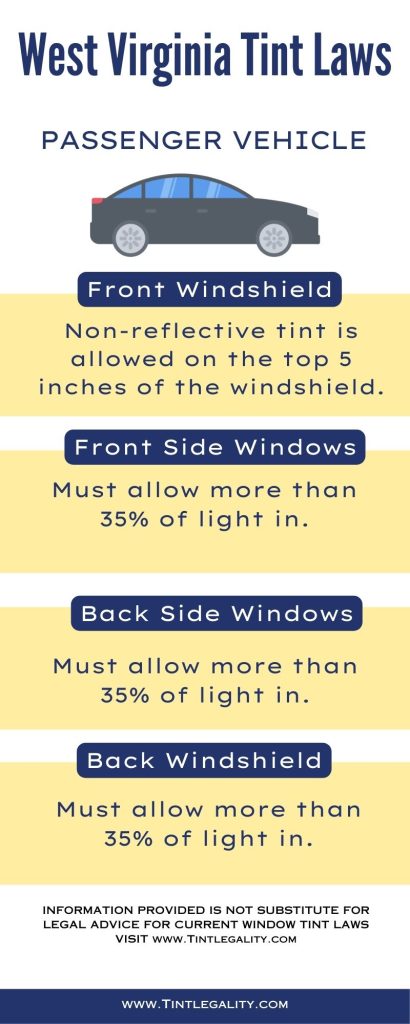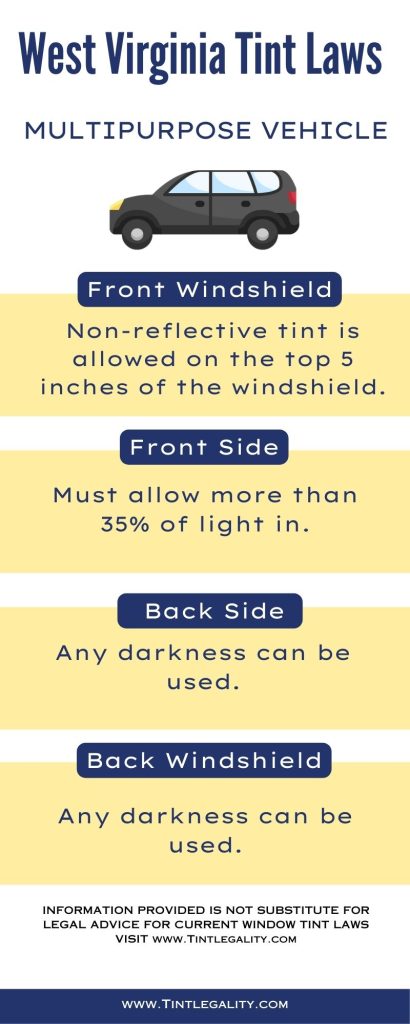West Virginia tint laws were enacted in 1991, and have served as a crucial guide for vehicle owners in the state ever since.
Understanding these rules not only aids in maintaining compliance but also ensures the safety of drivers and passengers alike.
Regulations Regarding Window Tint in West Virginia
One of the key regulations revolves around the Visible Light Transmission (VLT) percentage.
This denotes how much light is allowed to pass through your car windows.
The VLT laws differ depending on the vehicle type, i.e., sedan or SUV/van.
| Car Window | Tint Darkness for Sedans | Tint Darkness for SUVs and Vans | Tint Reflection |
|---|---|---|---|
| Windshield | Non-reflective tint allowed on top 5 inches | Non-reflective tint allowed on top 5 inches | Not specified |
| Front Side Windows | Must allow more than 35% light in | Must allow more than 35% light in | Must not be more than 20% reflective |
| Back Side Windows | Must allow more than 35% light in | Any tint darkness can be used | Must not be more than 20% reflective |
| Rear Window | Must allow more than 35% light in | Any tint of darkness can be used | Not specified |
Windshield
For both sedans and SUVs/vans, a non-reflective tint is permissible on the top five inches of the windshield.
This subtle tinting is designed to prevent the sun from directly shining in your eyes without obscuring your view.
Front Side Windows
Both types of vehicles must also adhere to a minimum VLT of 35%.
That means your front side windows need to let in at least 35% of the visible light, balancing privacy and safety.
Back Side Windows
In sedans, the back side windows also have to permit at least 35% of the light.
In contrast, SUVs and vans have more leniency; there’s no explicit restriction on how dark the tint can be.
Rear Window
The rear window follows the same rules as the back side windows, allowing for 35% light in sedans and flexibility in SUVs and vans.


Additional Regulations
Reflection
A notable provision within West Virginia tint laws relates to reflection.
Tints must not exceed 20% reflectivity on any window, for any vehicle type.
This is to prevent glare that could pose a danger to other drivers.
Medical Exemptions
West Virginia allows for medical exemptions to these rules. If you have a condition that warrants darker tints, you can apply for an exception.
However, proper documentation from a licensed physician is necessary.
Color Restrictions
Remember, not all tint colors are allowed.
In West Virginia, yellow, amber, and red tints are explicitly prohibited.
Side Mirrors
If you have a tint on the window behind the driver, dual side mirrors are required.
This law is designed to ensure drivers have an unobstructed view of the road, even with tinted windows.
Exceptions to Legal Limits
Manufacturers must certify the film they sell in West Virginia, and dealers need to use certified film.
In addition, a sticker to identify legal tinting is required on any film or glass-tinted car window.
Penalties for Breaking the Law
Fines
Non-compliance with these laws can result in a misdemeanor with fines up to $200.
First Conviction
For the first conviction, the penalty may seem minor. However, it serves as a clear warning to adhere to West Virginia tint laws.
Second Conviction
If a second conviction occurs, the penalties are likely to be more severe. This could include higher fines and potential points on your license.
Third Conviction
A third conviction is treated very seriously, potentially leading to maximum fines, license points, and other consequences.
Other Penalties
Beyond fines, non-compliance with West Virginia’s tint laws can also impact your car insurance.
Frequent violations might lead insurers to classify you as a high-risk driver, resulting in increased premiums.
Penalties for Non-Compliance
Beyond the financial consequences, having illegally tinted windows can potentially result in law enforcement having probable cause to stop your vehicle.
This could result in further scrutiny and potential additional legal consequences.
West Virginia’s tint laws have been in place since 1991 to provide a balance between privacy and safety.
Whether you’re a car owner in Charleston or a van driver in Huntington, knowing these regulations can save you a lot of trouble down the line.
It’s not just about compliance; it’s about ensuring the safety and comfort of everyone on the road.
References:
https://en.wikipedia.org/wiki/West_Virginia
https://www.wv.gov/Pages/default.aspx
http://www.wvlegislature.gov/WVCODE/ChapterEntire.cfm?chap=17c&art=15§ion=36A#15#15